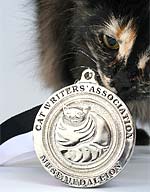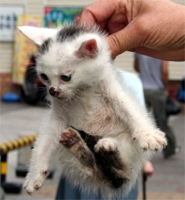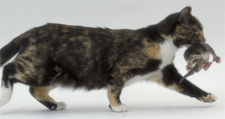 |
|||||||||||||||||||
|
|

We are the proud winners of the 2006 - 2009 winner of the Muse Medallion for Online Magazine by The Cat Writers? Association in their annual Communications Contest! (Photo courtesy of Weems Hutto).
On November 17, 2007 Felinexpress.com was honored to receive The President's Award by the Cat Writers' Association. We are very proud to have earned this distinction and will continue to provide quality information for all cat lovers.
Felinexpress.com home > Cat Care > How to Properly Scruff a Cat |
How to Properly Scruff a Cat
When a kitten first comes into the world and becomes separated from her littermates (if the Queen is a good mother) she will leave her litter and take that kitten in her mouth by the scruff of the neck. Then she will place her in with the other kittens lie back down and offer up her nipples. This grip on the neck is known as scruffing; referring to the scruff of the neck. However; if you look up the word scruffing in the dictionary, you won’t find it. Scruffing is a cat owner’s term.
As the kittens grow, the Queen will use this technique to “school” her kittens in how to behave. Properly teaching the kittens to be quiet when the Queen leaves the nest, or not to bite so hard or play to rough. Scruffing is the way that the Queen disciplines her kittens. If a kitten becomes unruly, the Queen will grasp the loose skin of the neck with her teeth and lean lightly into the kitten. You see this behavior more with barn cats than house cats. The Queen is telling her kitten to be still and simmer down as predators are near and the nest may be compromised.
Scruffing is basically a gentle but firm restraint technique for the cat or kitten. Done properly, it can temporarily calm a stressed kitten or cat. One should never attempt to scruff a cat that has just been engaged in a fight or an aggressive confrontation. Scruffing is used during routine and diagnostic procedures by your vet and vet staff. This is done for the protection of the cat, the staff and the owner.
When scruffing is necessary the way you approach your cat can speak volumes. Trying to be sneaky about it doesn’t work as cats are aware of even the slightest movement around them. Being that cats are a fight or flight animal, caution needs to be used when attempting to restrain a cat or a kitten. Don’t think that this tiny little kitten on the floor can’t do you damage. Even the smallest of kittens when first restrained by a human may fight with tooth and claw to get free. Unfortunately, we are not a good substitute for the Queen. Our touch can be both awkward and painful to the kitten or the cat.
When a cat’s space is invaded, the cat goes into a high-alert mode. Even a cat who has been injured isn’t going to take kindly to being scruffed. Their sympathetic nerve system causes epinephrine to release from their adrenal gland. This hormone causes an increase in blood flow and heart rate to the skeletal muscles, lungs and brain. If the cat is terrified, all it wants to do is cause harm to any living thing within striking distance. You should never underestimate the harm that an aggressive cat can do to you or the people around.
How to Properly Scruff a Cat:


Gently grasp the loose skin at that back of the head (close to the ears) and pinch lightly. Cats carry extra loose skin there and if you grasp the skin correctly, kitty can’t bite you. As you raise the cat up off the ground (unless it is in an aggressive state) take your free arm and lightly enfold the rear legs. This helps to carry the cat while scruffed. If the cat is fighting, you will need to grasp the rear legs to stop the cat’s movement.
If your cat is misbehaving (and most times they are only acting instinctively) you can restrain the cat gently by scruffing the neck and making kitty immobile for a few seconds either on the floor or on a table or chair. You should never restrain a cat in this way for a long period of time. Less than thirty seconds should be adequate to get the point across. If kitty squirms or fights release the hold immediately and let the kitty go. Don’t ever tighten your grip when scruffing or become rough with your cat or injuries could occur both to you and your cat.
Never pick up a full-grown adult cat by the scruff of the neck and hold him away from your body without support. Serious internal damage can occur. You can tear the delicate tissue of the neck or cause other internal damage. If you are scruffing an adult cat, be sure that you support the hind end as well with your free hand. If scruffing isn’t an option (if the cat is in aggressive mode, to heavy to scruff or injured) take a towel and move the cat so you can wrap him up in the towel and carry him where he needs to go. Scruffing needs to be done carefully and with consideration towards your cat. Otherwise, it can be a painful experience for both of you.
More cat breeds |
|
? Copyright 2006-2010 Felinexpress.com, All Rights Reserved
Privacy Statement - Disclaimer - About Me


